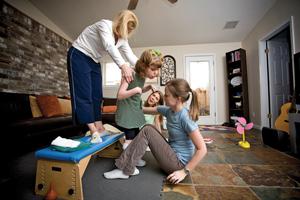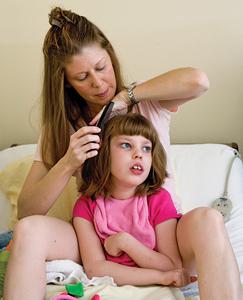Life with Neavey
By Katherine Duke '05
 |
It’s a balmy Saturday in January—one of the few times of year in Houston when it’s not too hot and humid to spend the afternoon outdoors. Keith Millner ’92 and his wife, Kelly, have pushed her daughter, Neavey, in a stroller around the peaceful residential neighborhood, and now the family sits in the side yard of their ranch-style home. The girl drifts in and out of sleep as her stepdad rocks her on the porch swing.
Suddenly, Neavey breaks her usual silence with a small moan. Her body stiffens, and her face turns red. Kelly jumps up to get a special magnet, the size of a cell phone; if she can use it quickly to activate the electronic implant in her daughter’s chest, it could stop this episode from progressing into a “giant barfing seizure”—the kind Neavey’s been having all too often lately. They’re lucky, this time, and after a few seconds, before Kelly can even reach the magnet, the seizure passes with no mess, and Neavey relaxes and falls back to sleep.
Doctors can offer no diagnosis more specific than “epilepsy” to name these incidents. Nor can they explain why the 9-year-old can’t talk or walk, why she can’t move or think like other children her age. Her parents might never know the exact cause or biological mechanism of the disorder that keeps her in a state of intellectual infancy.
Soon, Keith and Kelly take Neavey into the house, seat her in a special chair, cover her with a smock and give her a bottle of milk, into which they’ve mixed a dose of the seizure drug Keppra. Then Keith prepares her dinner—chicken ground up in the food processor, with a side of vegetable baby food—and measures out her other prescriptions: four capsules of Zonegran, also for the epilepsy; one and a half Klonopin pills to quicken and deepen her sleep (because seizures come most often in the intermediate stages between waking and sleeping); and several vitamins. Keith opens or grinds up each pill, sprinkles it onto the food and feeds Neavey the precise number of spoonfuls. Some of the vitamins are bitter, but, her parents believe, she’s lost her sense of taste anyway.
After dinner, Kelly undresses Neavey, and Keith lifts the girl into the bathtub (a tricky feat, as she’s all skinny arms and legs). Kelly puts on some country and folk music and talks to her daughter as she bathes her, ties back her wavy brown hair and eases her into a clean diaper and pink pajamas. Keith and Kelly lay her down to sleep on a bed next to theirs. A baby monitor will let them know if she has any more seizures this evening, while they’re eating their own dinner, and then they will go to bed and rest up for another day.
 |
Kelly McCord, an elementary school teacher, and Karl Ittmann, a professor of European history at the University of Houston, learned in 1998 that they were expecting a child. Kelly’s blood was negative for the antigen known as the Rh factor, while the fetus was Rh-positive. As is standard procedure in such cases, doctors gave Kelly injections to prevent her immune system from developing antibodies against Rh, which could attack a fetus in a future pregnancy. Otherwise, the nine months progressed normally.
Neave Marie Ittmann was born on April 26, 1999. (Neave is an alternative spelling of the traditional Irish name Niamh; it rhymes with sleeve.) Through her first months of life, she appeared healthy and got all the usual immunizations, plus a hepatitis B vaccine. That year, public concern about that vaccine’s safety and necessity had already prompted the Centers for Disease Control and the American Academy of Pediatrics to advise delaying it for babies not at particular risk for hepatitis, but Kelly says that doctors, family and friends suggested she and Karl allow it anyway.
In July, at 3 months old, Neavey began to develop strange little tics. They were barely noticeable at first—her leg would twitch momentarily, or her eyes would lock and her pupils dilate—but they grew more frequent. It took Kelly’s brother, trained as an EMT, to recognize what was really going on: the baby was having seizures.
By September, Neavey was having 10 to 20 seizures a day, leaving her too tired and weak to eat, drink and take her anti-seizure medication. Her parents checked her into the hospital. With her brain in a drugged state for six weeks, Neavey fell off the developmental charts. “She was a normal 4-month-old when she went into the hospital,” Kelly says, “and she came out in early October worse than an infant—she couldn’t even suck a bottle.” Karl’s sister, a neonatologist, helped Neavey to regain some ground, and Kelly took her to get every therapy and test she could find.
Over the next two years, Kelly and Karl held out hope that their normal child would come back to them, because Neavey was making gradual progress. “Mind you,” says Kelly, “you’d have to watch it with time-lapse photography.” But then an MRI revealed atrophy in the language center of the toddler’s brain. The confirmation of brain damage shook Kelly to the core.
Perplexingly, though, the brain damage didn’t appear to be caused or exacerbated by Neavey’s seizures, nor was it nearly extensive enough to explain her profound cognitive impairment. “With her level of brain damage,” Keith notes, “she could’ve gone to Amherst.” Her epilepsy has never been directly connected to her retardation, and, except for mild scoliosis, Neavey’s body is perfectly healthy.
The CDC maintains that the benefits of immunization vastly outweigh any risks and that there are major scientific flaws in the few studies that have presented a causal link between vaccines and disorders such as autism. But, like thousands of parents nationwide, Kelly is convinced that her child’s development was derailed by all those injections before and shortly after birth—specifically, by thimerosal, a mercury-based preservative in some of the vaccines. (At one point, the family was involved in legal action over the vaccine-injury issue, but the claim was ultimately denied.) In recent years, thimerosal has been removed from the vaccines routinely given to children in the United States.
Whatever its cause, Neavey’s condition affected Kelly and Karl’s physical and mental health. Grieving the loss of the child she might have been, tending to the child she had become and worrying about what lay ahead took its toll. It contributed to the collapse of their marriage.
Keith Millner arrived at Amherst in 1988, joining his brother Michael ’90. He sang with the Zumbyes and formed enduring friendships with a room group of eight other men. When he looks back, Keith sees a young man who was basically happy, who had plenty of fun, but who, at the same time, was troubled.
He says he spent college trying to escape his family problems—including the death of his mother during his freshman year—and feeling guilty for being who he was: straight, white, upper-middle-class and male. “I had this sense that what defined me and my place in the world was struggling against the weight of history that has put me up on this pedestal,” he says. His inward mantra, he recalls, was If you’re passively supporting the system, you’re actively oppressing people. But this angry activism filtered itself through his gentle voice and nurturing demeanor. “I didn’t want to make it worse,” he says simply. “I wanted to make it better.”
Each semester, he gravitated toward learning about “the Other,” double-majoring in anthropology and black studies. “I went to women’s and gender studies classes, history of homosexuality classes, black studies classes, where nine classes out of 10, I would be in the minority.” Rhonda Cobham-Sander, now the William R. Kenan Jr. Professor of Black Studies and English, was Keith’s adviser for his senior thesis on representations of race in African-American children’s picture books, and she stayed in touch with him for years after he graduated. “His thoughtfulness around issues that didn’t directly affect him—that’s the thing that always amazed me about him,” she says.
Also, says Cobham-Sander, “he was one of the first young men I met at Amherst who worked with children.” He’d had jobs at summer camps during high school, and at Amherst, he took a work-study position at Woodside Children’s Center, a daycare center affiliated with the college. “That, I think, led fairly naturally to an idea that I’d be interested in teaching,” he says.
His senior year, he did a student-teaching project with Barry O’Connell, now the James E. Ostendarp Professor of English. Following graduation, Keith taught at a primary school while earning his teaching certification through the University of Colorado Denver, where he later received a master’s degree in early childhood education. After a brief stint in the summer of 1998 teaching in a rural village in Tanzania—where, Cobham-Sander says, “he pushed that outsider thing to the absolute limit”—he got a job in the still-emerging field of online education, as well as a second master’s, from Harvard, in teacher leadership.
In 2002, Keith found work as an elementary literacy coach and went back to Denver—for good, he thought. He attended a training session for the job and, afterward, maintained e-mail correspondence with one of the trainers. Her name was Kelly McCord, she lived in Houston, and she had a husband and a daughter.
At first, Keith’s e-mail and phone contact with Kelly was purely professional: he would ask her advice about issues he faced in the classroom. But she began to open up about her own work and family life, including Keith on the e-mail list when she sent updates about her daughter’s condition. They became friends. After Kelly’s marriage ended, the friendship grew into something more.
There were plenty of reasons to stop the romance before it even got started. “I felt like, My God, what am I doing even beginning to explore a relationship with this person who’s in Houston and sort of tied there because she’s got this kid?” Keith says. “Kelly, to her great credit—I’m very grateful, to this day—kept at bay my compulsion to do what’s reasonable and logical.”
Still, Keith was cautious about getting to know Neavey. He didn’t want to form a bond with her until he was certain of his commitment to her mother. And his experiences as a teacher had made him, as a young man, doubt he could handle a disabled child of his own—let alone take on a little girl for whom the euphemism special needs doesn’t begin to cover it. Some friends, including other parents of developmentally disabled children, were tempted to advise him to run. “We admired that he took a lot of time for discussion with family [and] friends and did a lot of soul-searching,” says his friend Connie Morgan. “We, selfishly, were scared for Keith.”
 Kelly and Keith use baby spoons to dole out Neavey's food. |
When the long-distance relationship entered its second year, Keith began spending more time with Neavey, his initial discomfort with her messy feedings, constant seizures and deep impairments rapidly fading away. In part, this was because he experienced, in his words, “an evolution” in his attitude toward disability. “But also,” he says, “I think, on some level, I just fell in love with her.” He felt proud to be with her in public and happy to spend quiet evenings with Kelly, watching Neavey sleep. “Looking at this kid and being with this woman—it just felt like my life.”
In 2004, Kelly made plans to move with Neavey to Denver. But when Karl insisted on keeping Neavey in Houston and maintaining joint custody, Keith moved to Houston instead.
Keith and Kelly got married in 2006 in the mountains near Denver. Relatives, neighbors and Keith’s entire Amherst room group gathered to celebrate. At the ceremony, Keith spoke vows not only to Kelly but to his new stepdaughter as well (see “Vows”).That day, thanks to problems with her medication, Neavey suffered more than 100 seizures. But the 7-year-old looked beautiful in her crocheted sweater and long blue skirt, a turquoise pillow behind her head.
In Keith and Kelly Millner’s house in Houston, the shelves and walls display children’s books, African and African-American sculptures and paintings, Kelly’s teaching awards, a poster from a Zumbyes concert and pictures of their little girl. Neavey alternates, every few days, between their house and Karl’s, just minutes away.
Keith is a program manager and reading and vocabulary specialist at the Children’s Learning Institute at the University of Texas Houston Health Science Center. He is also an adjunct instructor for Westwood College Online. Kelly does some work at CLI, too, and is a substitute teacher in the public elementary school where she used to teach full-time.
 Therapists regularly arrive at the house to treat Neavey. |
During the week, Keith and Kelly drive Neavey in their custom, wheelchair-accessible van to and from another public school, where she’s in class with several other severely retarded children. Teachers challenge Neavey to press buttons, shake rattles and turn her big blue eyes toward whoever is speaking to her. “Most of the work is around getting her to initiate interaction with anything outside of herself,” Keith says. “She’s not great at that, but responding to it is the next best thing.” Most parents don’t turn on violent cartoons and loud rap music for their elementary schoolers; they wouldn’t make sharp trilling noises in their children’s ears. But Kelly and Keith laughingly acknowledge that they do all these things for Neavey—anything to get a rise out of her. “It’s like she gets this jolt,” Keith says, “this reminder of what it feels like to be alive, to be aware.”
Lately, Neavey seems, to her parents, happier and more responsive to people. At age 3, when Keith met Neavey, she would become absorbed in repetitive hand-rubbing and teeth-grinding—self-stimulating behaviors often exhibited by autistic children. But that 3-year-old could also sit up, carry a spoon to her mouth and cross a room with a walker; around her fourth birthday, over a matter of months, she lost most of those abilities. Her motor skills have been in general decline ever since. (Her parents describe this in terms like “nosedive” and “crater.”) Keith explains: “The reason that Neavey gets worse is just because she’s growing. Little bodies are easier to manage, and she was proportionately much stronger as a little kid.” Equipment that she’s outgrown is in the garage, while the standing frame (a vertical contraption that keeps her in a standing position), special chairs and toys for her current therapies are in a spare room that Keith and Kelly call “the parking lot.” The physical, occupational and speech therapists visit twice a week to work with her on skills such as rolling, standing, holding up her head, grasping her toys and chewing.
 Keith administers an inhaler to Neavey, who is sick with a cold. |
Her epilepsy is largely, though not entirely, under control through a cocktail of drugs and vitamins. In 2004, having tried every other treatment, her parents had doctors implant a vagus nerve stimulator (VNS) just below her left collar bone. This was a fairly new therapy with widely varying results in other epileptic children. Similar to a pacemaker, the device sends regular, mild electric signals up the vagus nerve from her neck to her brain and can also be activated by an external magnet to curtail a seizure in progress. “There was hope, certainly, that there would be a magic bullet,” Keith remembers. But the VNS ruined Neavey’s appetite and wasn’t doing very much to stop the seizures, so they’ve had it turned down to a very low setting. When Neavey has a seizure, they still “wave the stupid magnet,” Keith says, almost like a magic wand.
The real trouble comes on the rare occasion that Neavey catches a bug. “If Neavey gets sick, all the world stops,” Kelly says. Congestion and lethargy make it harder for her to swallow food and meds; a stomach virus can make her vomit them up; a fever can change the way she metabolizes them. Any irregularity in her dosing then catches up with her, a few days or weeks later, when she could have hundreds of seizures.
 After pulling over the car, Kelly helps her dehydrated daughter. |
Neavey isn’t especially medically fragile, but there’s no telling what problems might arise tomorrow, or next year, or when she’s an adult. Having no diagnosis means she has no prognosis. The most her neurologist can predict is that her seizures will change, in frequency and type, over the years. And, of course, she will grow and develop physically, if not cognitively. For now, she’s still small and thin enough to fit into toddler-sized diapers. But her body will become more cumbersome, her care more complicated.
Keith and Kelly have read about the so-called “Pillow Angel” case, in which parents had doctors stunt the growth of their severely disabled daughter and remove her reproductive organs to increase her comfort and the ease of her care. The case sparked an international debate about the best interests, dignity and autonomy of children and of people with disabilities. While Neavey’s parents say they would never take such drastic measures, they empathize. “We know how friggin’ hard it is,” Keith says, “and the prospect of Neavey getting bigger and older is terrifying to us.”
 The family in a quiet moment. |
Kelly sometimes can’t help but foresee the worst. “The way that Kelly responds, any time her phone rings when we don’t have Neavey, is panicked, instantly,” says Keith. Kelly fills notebooks with the details of her child’s daily routine—medication dosages, diaper changes, even what side they lay her on to sleep—knowing that these records could help in an emergency. Moreover, they may be a factor when Neavey turns 18 and Kelly will seek legal guardianship. “If I’m lucky, Neavey will die before I do,” she says. “She won’t be here without us.”
Many of Keith and Kelly’s siblings and friends are now raising healthy, active, “normal” children. “Their kids are smart and able, and they go to soccer practice and private school, and their lives are fancy and a million miles a minute,” Keith says. “And they’re good people—I don’t think they’re in any way disdainful of us—but they can be dismissive of the possibility that [our life] could be their life. Literally, at any minute, it could be them.”
Some people have trouble with Neavey’s drooling, her silence, the subtlety—or absence—of her interpersonal response. “Neavey’s just a mirror,” Keith theorizes. “She literally couldn’t hurt you in any way, so if there’s something about Neavey that makes a person uncomfortable, that’s something in them.” What upsets Kelly is when friends and family can’t work through their sadness over Neavey’s condition so they can move on from it. “They feel the grief and sorrow and fear that having Neavey puts into our life,” Keith says. “They don’t identify and connect with the joy and comfort she brings.”
 Kelly brushes Neavey's hair. |
Anytime Neavey vocalizes or succeeds in therapy, it’s a victory, an occasion to break out the video camera. Kelly takes pleasure in dressing her in colorful outfits and bringing her to a hairstylist. When Neavey gives Keith a smile or laugh, he thinks, “That is all I ever need in my life.”
Yet she might be seen as the ultimate Other—whatever is going on in her unusual mind remains hidden in there. She is less aware and responsive than most pets, Keith and Kelly say. “Neavey challenges our ideas of what it means to be human,” Keith says, “because she doesn’t qualify in any of the ways that most of the people I’ve ever known define themselves as individuals or as human.” Some people see her as an “angel”—and Keith appreciates their reverence. But, he knows, Neavey is a person. “And the way that I know she is, is because that’s the way I love her.”
In anthropology class at Amherst, Keith learned that we study the Other mainly to learn about ourselves. And from Professor Cobham-Sander, he heard this message: “History is not a linear progression,” she wrote as he struggled with his thesis. “We fight not because we know that things must get better but because we know they can get worse.”
Keith sees more problems than ever in the world, but he is no longer so angry. In an e-mail to Amherst, he wrote:
[I]n my life with Neavey, I am, in some ways, becoming an adult, reaching what feels like the real lesson of what I was learning about passion and service and struggle when I was a young adult at Amherst. … I am compelled by a life of service not because I can make things better. I am not even compelled anymore by a belief that I struggle so things won’t get worse. Neavey’s not going to get better, and while my struggle to care for her certainly slows the speed of her decline, she will get worse. Why I serve, simply, is because I want to. It feels good to me. It is who I am, and I feel most myself and like my best self when I am with Neavey and dedicating myself completely to her care. I serve out of selfishness and because I am in love.
As far as anyone can tell, Neavey holds no grudges, expectations or worries—she lives in the moment. Keith and Kelly try to do the same. “If we started thinking about all those ‘what-ifs,’ it would paralyze us,” Keith says.
 |
They do hope their future will include another child. The couple has undergone genetic counseling and testing; Neavey’s condition does not seem to be hereditary. So far, though, they’ve been unable to conceive, and the two years of trying have proved “really sad.” Still, Keith and Kelly remain optimistic, especially now that Keith has had a surgical procedure that doctors say will improve their chances. The medical costs put a strain on their already tight finances (as would the fees for adoption, though they’re seriously considering that route). Even if they do have a baby, there are a host of other worries. “Having two infants at home, one of whom weighs 50 pounds, is kinda scary,” Keith says—and they’re nervous about the possibility of twins, or of bringing home another child with special needs.
Of all people, Keith and Kelly know how little control they have over what their family might look like and who their children might be. But they know they’ll be okay, no matter what. “That’s part of what I take to be a gift of my life with Neavey. Now I know we can pretty much pull off anything,” Keith says. “If I thought about it for a second, I’d realize I have no idea how we’re going to manage it. But it’s not scary, because we’ve already figured out so much in our lives—we’ll figure out whatever comes next. We will.”
Katherine Duke ’05, a writer and editor at Amherst magazine, is the college’s Ives Washburn Fellow.
Keith Millner ’92 can be reached at kamillner@yahoo.com.
Photos by Samuel Masinter '04